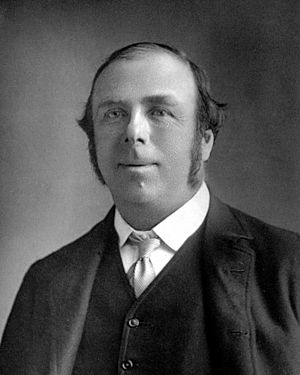Robert Stawell Ball facts for kids
Quick facts for kids
Professor
Sir Robert Stawell Ball
|
|
|---|---|
 |
|
| Royal Astronomer of Ireland | |
| In office 1874–1892 |
|
| Preceded by | Franz Brünnow |
| Succeeded by | Arthur Alcock Rambaut |
| Personal details | |
| Born | 1 July 1840 Dublin, Ireland |
| Died | 25 November 1913 (aged 73) Cambridge, England |
| Alma mater | Trinity College Dublin |
| Known for | Screw theory |
Sir Robert Stawell Ball (born July 1, 1840 – died November 25, 1913) was an important Irish astronomer and mathematician. He is famous for creating something called the screw theory. He also held the special job of Royal Astronomer of Ireland at the Dunsink Observatory.
Contents
Meet Sir Robert Stawell Ball
Sir Robert Stawell Ball was a brilliant scientist who helped us understand the stars and how things move. He was born in Dublin, Ireland, and became a well-known professor and writer.
His Early Life and Learning
Robert was born in Dublin. His father, Robert Ball, was a naturalist who studied nature. Robert went to Trinity College Dublin, a famous university. He was very good at math and science, earning a scholarship in 1859.
After college, from 1865 to 1867, he worked for Lord Rosse, another famous astronomer. In 1867, Robert became a professor at the Royal College of Science in Dublin. There, he taught about how things move, a subject called mechanics.
A Career Among the Stars
In 1874, Robert Ball got a very important job: he became the Royal Astronomer of Ireland. This meant he was the top astronomer in Ireland. He worked at the Dunsink Observatory in Dublin.
He was also made a Fellow of the Royal Society in 1873. This is a big honor for scientists.
Understanding Movement: Screw Theory
One of Robert Ball's biggest contributions was his work on something called the "screw theory." This theory helps explain how objects move in space. It's not just about actual screws, but about all the possible ways any object can move. His book, The Theory of Screws, was published in 1876.
Because of his work on screw theory, he received the Cunningham Medal in 1879. This is a special award from the Royal Irish Academy.
Sharing Science with Everyone
Robert Ball loved to share his knowledge with the public. He wrote many articles and books that were easy for people to understand.
- In 1882, his article "A Glimpse through the Corridors of Time" was published.
- He wrote about "The Boundaries of Astronomy" in 1883.
- He was knighted in 1886, which means he was given the title "Sir."
- His book Time and Tide: a Romance of the Moon (1889) explained how tides work.
- He also wrote The Cause of an Ice Age (1891) and An Atlas of Astronomy (1892).
His most famous book for the public was The Story of the Heavens, first published in 1886. It made astronomy exciting for many people.
Moving to Cambridge
In 1892, Sir Robert moved to England. He became a professor at Cambridge University and the director of the Cambridge Observatory. He continued to write and teach there.
In 1908, he published A Treatise on Spherical Astronomy. This was a textbook for students learning about astronomy. It covered topics like how to use a telescope and how light from stars behaves.
Sir Robert was also the President of the Mathematical Association in 1900.
His Lectures and Legacy
Sir Robert Ball was famous for his public lectures on science. He gave about 2500 lectures between 1875 and 1910 across Britain and Ireland. He made complex science topics fun and easy to understand for everyone.
He was invited to give the famous Royal Institution Christmas Lectures several times. These lectures are for young people and are a great way to learn about science.
Sir Robert's books, like Starland and The Story of the Heavens, were very popular. They helped many people learn about the universe.
The minor planet 4809 Robertball is named after him. This is a great honor for an astronomer!
His Final Years
Sir Robert Stawell Ball passed away in Cambridge, England, on November 25, 1913. He was buried there with his wife, Lady Francis Elizabeth Ball.
His son, W.V. Ball, wrote a book about his life called Reminiscences and Letters of Sir Robert Ball.

